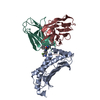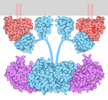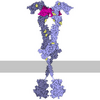[English] 日本語
 Yorodumi
Yorodumi- PDB-9o55: Structure of a synthetic antibody (RM010) in complex with a class... -
+ Open data
Open data
- Basic information
Basic information
| Entry | Database: PDB / ID: 9o55 | ||||||||||||||||||||||||
|---|---|---|---|---|---|---|---|---|---|---|---|---|---|---|---|---|---|---|---|---|---|---|---|---|---|
| Title | Structure of a synthetic antibody (RM010) in complex with a class I MHC presenting a hapten-peptide conjugate | ||||||||||||||||||||||||
 Components Components |
| ||||||||||||||||||||||||
 Keywords Keywords | IMMUNE SYSTEM / Complex / Fab | ||||||||||||||||||||||||
| Function / homology |  Function and homology information Function and homology informationresponse to mineralocorticoid / GMP binding / forebrain astrocyte development / LRR domain binding / regulation of synaptic transmission, GABAergic / negative regulation of epithelial cell differentiation / response to isolation stress / response to gravity / epithelial tube branching involved in lung morphogenesis / type I pneumocyte differentiation ...response to mineralocorticoid / GMP binding / forebrain astrocyte development / LRR domain binding / regulation of synaptic transmission, GABAergic / negative regulation of epithelial cell differentiation / response to isolation stress / response to gravity / epithelial tube branching involved in lung morphogenesis / type I pneumocyte differentiation / Rac protein signal transduction / positive regulation of Rac protein signal transduction / antigen processing and presentation of peptide antigen via MHC class I / Signaling by RAS GAP mutants / Signaling by RAS GTPase mutants / Activation of RAS in B cells / myoblast proliferation / skeletal muscle cell differentiation / RAS signaling downstream of NF1 loss-of-function variants / RUNX3 regulates p14-ARF / positive regulation of glial cell proliferation / SOS-mediated signalling / Activated NTRK3 signals through RAS / Activated NTRK2 signals through RAS / SHC1 events in ERBB4 signaling / cardiac muscle cell proliferation / Signalling to RAS / Activated NTRK2 signals through FRS2 and FRS3 / SHC-related events triggered by IGF1R / Estrogen-stimulated signaling through PRKCZ / glial cell proliferation / SHC-mediated cascade:FGFR3 / MET activates RAS signaling / SHC-mediated cascade:FGFR2 / PTK6 Regulates RHO GTPases, RAS GTPase and MAP kinases / Signaling by PDGFRA transmembrane, juxtamembrane and kinase domain mutants / Signaling by PDGFRA extracellular domain mutants / SHC-mediated cascade:FGFR4 / Erythropoietin activates RAS / SHC-mediated cascade:FGFR1 / Signaling by FGFR4 in disease / FRS-mediated FGFR3 signaling / Signaling by CSF3 (G-CSF) / Signaling by FLT3 ITD and TKD mutants / FRS-mediated FGFR2 signaling / FRS-mediated FGFR4 signaling / FRS-mediated FGFR1 signaling / p38MAPK events / Signaling by FGFR3 in disease / protein-membrane adaptor activity / Tie2 Signaling / striated muscle cell differentiation / Signaling by FGFR2 in disease / GRB2 events in EGFR signaling / Signaling by FLT3 fusion proteins / SHC1 events in EGFR signaling / FLT3 Signaling / Signaling by FGFR1 in disease / EGFR Transactivation by Gastrin / NCAM signaling for neurite out-growth / CD209 (DC-SIGN) signaling / homeostasis of number of cells within a tissue / Downstream signal transduction / GRB2 events in ERBB2 signaling / Insulin receptor signalling cascade / Ras activation upon Ca2+ influx through NMDA receptor / SHC1 events in ERBB2 signaling / response to glucocorticoid / Constitutive Signaling by Overexpressed ERBB2 / Signaling by phosphorylated juxtamembrane, extracellular and kinase domain KIT mutants / VEGFR2 mediated cell proliferation / small monomeric GTPase / lumenal side of endoplasmic reticulum membrane / FCERI mediated MAPK activation / liver development / ER to Golgi transport vesicle membrane / female pregnancy / RAF activation / Signaling by ERBB2 TMD/JMD mutants / Signaling by SCF-KIT / Constitutive Signaling by EGFRvIII / Signaling by high-kinase activity BRAF mutants / regulation of long-term neuronal synaptic plasticity / MAP2K and MAPK activation / Signaling by ERBB2 ECD mutants / visual learning / Signaling by ERBB2 KD Mutants / MHC class I protein complex / cytoplasmic side of plasma membrane / phagocytic vesicle membrane / recycling endosome membrane / cytokine-mediated signaling pathway / Regulation of RAS by GAPs / Signaling by CSF1 (M-CSF) in myeloid cells / RAS processing / Negative regulation of MAPK pathway / Signaling by RAF1 mutants / Signaling by moderate kinase activity BRAF mutants / Paradoxical activation of RAF signaling by kinase inactive BRAF / Signaling downstream of RAS mutants Similarity search - Function | ||||||||||||||||||||||||
| Biological species |  Homo sapiens (human) Homo sapiens (human) | ||||||||||||||||||||||||
| Method | ELECTRON MICROSCOPY / single particle reconstruction / cryo EM / Resolution: 2.88 Å | ||||||||||||||||||||||||
 Authors Authors | Hu, Z. / Rajak, E. / Maso, L. / Koide, S. | ||||||||||||||||||||||||
| Funding support |  United States, 1items United States, 1items
| ||||||||||||||||||||||||
 Citation Citation |  Journal: Proc Natl Acad Sci U S A / Year: 2025 Journal: Proc Natl Acad Sci U S A / Year: 2025Title: Generation of actionable, cancer-specific neoantigens from KRAS(G12C) with adagrasib. Authors: Lorenzo Maso / Epsa Rajak / Takamitsu Hattori / Zhengshan Hu / Akiko Koide / Benjamin G Neel / Shohei Koide /  Abstract: Effective immune therapy against cancer ideally should target a cancer-specific antigen, an antigen that is present exclusively in cancer cells. However, there is a paucity of cancer-specific ...Effective immune therapy against cancer ideally should target a cancer-specific antigen, an antigen that is present exclusively in cancer cells. However, there is a paucity of cancer-specific antigens that are endogenously produced. HapImmune™ technology utilizes covalent inhibitors directed to an intracellular cancer driver to create cancer-specific neoantigens in the form of drug-peptide conjugates presented by class I MHC molecules. Our previous study with sotorasib, an FDA-approved covalent inhibitor of KRAS(G12C), demonstrated that drug-treated cells produce such neoantigens and can be killed by T cell engagers directed against the drug-peptide/MHC complex. Thus, this technology can unite targeted and immune therapies. In the present study, we examined whether this approach could generalize to another FDA-approved KRAS(G12C) inhibitor, adagrasib, whose chemical structure and cysteine reactivity differ substantially from sotorasib. We developed antibodies selective to adagrasib-KRAS(G12C) peptides presented by HLA-A*03 and A*11 that also show cross-reactivity to other KRAS(G12C) inhibitors presented in the same manner. Cryoelectron microscopy structures revealed a mode of adagrasib-peptide/HLA recognition distinctly different from that of sotorasib-directed HapImmune antibodies. The antibodies in a bispecific T cell engager format killed adagrasib-resistant lung cancer cells upon adagrasib treatment. These results support the broad applicability of the HapImmune approach for creating actionable cancer-specific neoantigens and offer candidates for therapeutic development. | ||||||||||||||||||||||||
| History |
|
- Structure visualization
Structure visualization
| Structure viewer | Molecule:  Molmil Molmil Jmol/JSmol Jmol/JSmol |
|---|
- Downloads & links
Downloads & links
- Download
Download
| PDBx/mmCIF format |  9o55.cif.gz 9o55.cif.gz | 86.4 KB | Display |  PDBx/mmCIF format PDBx/mmCIF format |
|---|---|---|---|---|
| PDB format |  pdb9o55.ent.gz pdb9o55.ent.gz | Display |  PDB format PDB format | |
| PDBx/mmJSON format |  9o55.json.gz 9o55.json.gz | Tree view |  PDBx/mmJSON format PDBx/mmJSON format | |
| Others |  Other downloads Other downloads |
-Validation report
| Summary document |  9o55_validation.pdf.gz 9o55_validation.pdf.gz | 1.4 MB | Display |  wwPDB validaton report wwPDB validaton report |
|---|---|---|---|---|
| Full document |  9o55_full_validation.pdf.gz 9o55_full_validation.pdf.gz | 1.4 MB | Display | |
| Data in XML |  9o55_validation.xml.gz 9o55_validation.xml.gz | 33.4 KB | Display | |
| Data in CIF |  9o55_validation.cif.gz 9o55_validation.cif.gz | 46.6 KB | Display | |
| Arichive directory |  https://data.pdbj.org/pub/pdb/validation_reports/o5/9o55 https://data.pdbj.org/pub/pdb/validation_reports/o5/9o55 ftp://data.pdbj.org/pub/pdb/validation_reports/o5/9o55 ftp://data.pdbj.org/pub/pdb/validation_reports/o5/9o55 | HTTPS FTP |
-Related structure data
| Related structure data |  70124MC M: map data used to model this data C: citing same article ( |
|---|---|
| Similar structure data | Similarity search - Function & homology  F&H Search F&H Search |
- Links
Links
- Assembly
Assembly
| Deposited unit | 
|
|---|---|
| 1 |
|
- Components
Components
| #1: Protein | Mass: 21081.148 Da / Num. of mol.: 1 Source method: isolated from a genetically manipulated source Source: (gene. exp.)  Homo sapiens (human) / Gene: HLA-A / Production host: Homo sapiens (human) / Gene: HLA-A / Production host:  |
|---|---|
| #2: Protein/peptide | Mass: 889.094 Da / Num. of mol.: 1 Source method: isolated from a genetically manipulated source Source: (gene. exp.)  Homo sapiens (human) / Gene: KRAS, KRAS2, RASK2 / Production host: Homo sapiens (human) / Gene: KRAS, KRAS2, RASK2 / Production host:  |
| #3: Antibody | Mass: 12432.712 Da / Num. of mol.: 1 Source method: isolated from a genetically manipulated source Source: (gene. exp.)  Homo sapiens (human) / Production host: Homo sapiens (human) / Production host:  |
| #4: Antibody | Mass: 11914.289 Da / Num. of mol.: 1 Source method: isolated from a genetically manipulated source Source: (gene. exp.)  Homo sapiens (human) / Production host: Homo sapiens (human) / Production host:  |
| #5: Chemical | ChemComp-A1B8E / [( Mass: 606.133 Da / Num. of mol.: 1 / Source method: obtained synthetically / Formula: C32H37ClFN7O2 / Feature type: SUBJECT OF INVESTIGATION |
| Has ligand of interest | Y |
| Has protein modification | Y |
-Experimental details
-Experiment
| Experiment | Method: ELECTRON MICROSCOPY |
|---|---|
| EM experiment | Aggregation state: PARTICLE / 3D reconstruction method: single particle reconstruction |
- Sample preparation
Sample preparation
| Component | Name: Binary complex of Fab RM010 with adagrasib-conjugated KRAS G12C peptide presented by HLA-A11 Type: COMPLEX / Entity ID: #1, #4, #3 / Source: RECOMBINANT |
|---|---|
| Source (natural) | Organism:  Homo sapiens (human) Homo sapiens (human) |
| Source (recombinant) | Organism:  |
| Buffer solution | pH: 7.4 |
| Specimen | Embedding applied: NO / Shadowing applied: NO / Staining applied: NO / Vitrification applied: YES |
| Vitrification | Cryogen name: ETHANE |
- Electron microscopy imaging
Electron microscopy imaging
| Experimental equipment |  Model: Titan Krios / Image courtesy: FEI Company |
|---|---|
| Microscopy | Model: TFS KRIOS |
| Electron gun | Electron source:  FIELD EMISSION GUN / Accelerating voltage: 300 kV / Illumination mode: FLOOD BEAM FIELD EMISSION GUN / Accelerating voltage: 300 kV / Illumination mode: FLOOD BEAM |
| Electron lens | Mode: BRIGHT FIELD / Nominal defocus max: 2500 nm / Nominal defocus min: 500 nm |
| Image recording | Electron dose: 47.31 e/Å2 / Film or detector model: GATAN K3 (6k x 4k) |
- Processing
Processing
| CTF correction | Type: PHASE FLIPPING AND AMPLITUDE CORRECTION | ||||||||||||||||||||||||
|---|---|---|---|---|---|---|---|---|---|---|---|---|---|---|---|---|---|---|---|---|---|---|---|---|---|
| 3D reconstruction | Resolution: 2.88 Å / Resolution method: FSC 0.143 CUT-OFF / Num. of particles: 155365 / Symmetry type: POINT | ||||||||||||||||||||||||
| Atomic model building | B value: 106.4 | ||||||||||||||||||||||||
| Refinement | Stereochemistry target values: REAL-SPACE (WEIGHTED MAP SUM AT ATOM CENTERS) | ||||||||||||||||||||||||
| Refine LS restraints |
|
 Movie
Movie Controller
Controller


 PDBj
PDBj





















